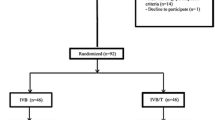Abstract
To evaluate the effectiveness of an intravitreal bevacizumab injection on retinal neovascularization and diabetic macular edema (DME) refractory to laser photocoagulation therapy. Thirty-four eyes of 22 patients with proliferative diabetic retinopathy and DME refractory to laser photocoagulation therapy received an intravitreal injection of 1.25 mg/0.05 ml of bevazicumab. Changes in mean best-corrected visual acuity (BCVA), central macular thickness (CMT), regression of neovascularization over time, and correlation between BCVA and CMT were evaluated. Follow-up visits were at weeks 1, 2 and 4 and months 3 and 6. Mean BCVA was significantly better than baseline only at week 2 (P = 0.036). Mean CMT decreased significantly from baseline at weeks 1, 2, and 4 (P = 0.001). At months 3 and 6, mean CMT increased, albeit insignificantly (P = 0.804 and P = 1.0). The decrease in fluorescein leakage was moderate in all eyes at the end of week 1. At week 2, there was total resolution of fluorescein leakage in 24 (70.5%) eyes and moderate resolution in 10 (29.5%) eyes. At the end of month 3, the fluorescein leakage was fully resolved in 5 (14.7%) eyes, moderately resolved in 24 (70.5%) eyes, and was similar to baseline in 5 (14.7%) eyes. At month 6, the fluorescein leakage was fully resolved in 3 (8.8%) eyes, moderately resolved in 20 (58.8%) eyes, and was similar to baseline in 11 (32.4%) eyes. A moderate but insignificant negative correlation was found between visual acuity and CMT (P > 0.05). Persistence or recurrence of neovascular tissue after panretinal photocoagulation may be attributed to the production of vascular endothelial growth factor by the residual ischemic retina, which also results in persistent or recurrent DME despite macular grid photocoagulation.




Similar content being viewed by others
References
Early Treatment Diabetic Retinopathy Study Research Group (1991) Fundus photographic risk factors for progression of diabetic retinopathy. ETDRS report number 12. Ophthalmology 98:823–833
Schwartz SG, Flynn HW Jr (2007) Pharmacotherapies for diabetic retinopathy: present and future. Exp Diabetes Res 2007:524–587
Diabetes Control Complications Trial Research Group (1993) The effect of intensive treatment of diabetes on the development and progression of long-term complications in insulin dependent diabetes mellitus. N Engl J Med 329:977–986
Vander JF, Duker JS, Benson WE et al (1991) Long-term stability and visual outcome after favorable initial response of proliferative diabetic retinopathy to panretinal photocoagulation. Ophthalmology 98:1575–1579
Fong DS, Aiello LP, Ferris FL III, Klein R (2004) Diabetic retinopathy. Diabetes Care 27:2540–2553
Flynn HW Jr, Chew EY, Simons BD et al (1992) Pars plana vitrectomy in the Early Treatment Diabetic Retinopathy Study. ETDRS report number 17. Ophthalmology 99:1351–1357
Adamis AP, Miller JW, Bernal MT et al (1994) Increased vascular endothelial growth factor levels in the vitreous of eyes with proliferative diabetic retinopathy. Am J Ophthalmol 118:445–450
Aiello LP, Avery RL, Arrigg PG et al (1994) Vascular endothelial growth factor in ocular fluid of patients with diabetic retinopathy and other retinal disorders. N Engl J Med 331:1480–1487
Adamis AP, Altaweel M, Bressler NM et al (2006) Changes in retinal neovascularization after pegaptanib (Macugen) therapy in diabetic individuals. Ophthalmology 113:23–28
Haritoglou C, Kook D, Neubauer A et al (2006) Intravitreal bevacizumab (Avastin) therapy for persistent diffuse diabetic macular edema. Retina 26:999–1005
Jorge R, Costa RA, Calucci D (2006) Intravitreal bevacizumab (Avastin) for persistent new vessels in diabetic retinopathy (IBEPE study). Retina 26:1006–1013
Hurwitz H, Fehrenbacher L, Novotny W et al (2004) Bevacizumab plus irinotecan, fluorouracil, and leucovorin for metastatic colorectal cancer. N Engl J Med 350:2335–2342
Oshima Y, Sakaguchi H, Gomi F (2006) Regression of iris neovascularization after intravitreal injection of bevacizumab in patients with proliferative diabetic retinopathy. Am J Ophthalmol 142:155–157
Avery RL, Pearlman J, Pieramici DJ (2006) Intravitreal bevacizumab (Avastin) in the treatment of proliferative diabetic retinopathy. Ophthalmology 113:1695–1705
Spaide RF, Fisher YL (2006) Intravitreal bevacizumab (Avastin) treatment of proliferative diabetic retinopathy complicated by vitreous hemorrhage. Retina 26:275–278
Aiello LP, Brucker AJ, Chang S et al (2004) Evolving guidelines for intravitreous injections. Retina 24:13–19
Shimura M, Yasuda K, Nakazawa T et al (2003) Quantifying alterations of macular thickness before and after panretinal photocoagulation in patients with severe diabetic retinopathy and good vision. Ophthalmology 110:2386–2394
Arevalo JF, Fromow-Guerra J, Quiroz-Mercado H et al (2007) Primary intravitreal bevacizumab (Avastin) for diabetic macular edema: results from the Pan-American Collaborative Retina Study Group at 6-month follow-up. Ophthalmology 114:743–750
Nguyen QD, Tatlipinar S, Shah SM et al (2006) Vascular endothelial growth factor is a critical stimulus for diabetic macular edema. Am J Ophthalmol 142:961–969
Diabetic Retinopathy Clinical Research Network (2007) A phase II randomized clinical trial of intravitreal bevacizumab for diabetic macular edema. Ophthalmology 114:1860–1867
Conflict of interest
None.
Author information
Authors and Affiliations
Corresponding author
Rights and permissions
About this article
Cite this article
Gulkilik, G., Taskapili, M., Kocabora, S. et al. Intravitreal bevacizumab for persistent macular edema with proliferative diabetic retinopathy. Int Ophthalmol 30, 697–702 (2010). https://doi.org/10.1007/s10792-010-9403-y
Received:
Accepted:
Published:
Issue Date:
DOI: https://doi.org/10.1007/s10792-010-9403-y




